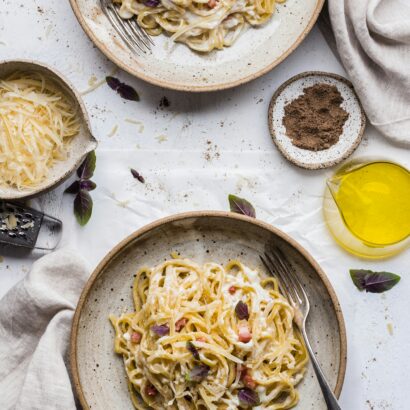Introduction
Pasta is a universal comfort food, cherished for its versatility and satisfying texture. However, traditional pasta can be high in calories and carbohydrates, which may not suit everyone’s dietary needs. Fortunately, a variety of low-calorie pasta alternatives are available, allowing you to enjoy your favorite dishes without compromising your health goals. This article delves into these alternatives, exploring their benefits, preparation methods, and culinary versatility.
The Pasta Dilemma

Traditional pasta, typically made from refined wheat, is rich in carbohydrates and calories. While it offers a quick source of energy, it can lead to spikes in blood sugar and is often not ideal for those watching their calorie or carbohydrate intake. This has led to a growing interest in low-calorie alternatives that offer similar satisfaction without the caloric load.
Zucchini Noodles (Zoodles)

Zucchini noodles, or “zoodles,” are a popular choice for those seeking a fresh, low-calorie alternative to pasta. Made by spiralizing zucchini, zoodles are incredibly versatile and can be easily incorporated into various dishes.
Nutritional Profile and Benefits
Zoodles contain about 20 calories per cup, making them a fraction of the calories found in traditional pasta. They are also rich in vitamins A and C, potassium, and antioxidants. These nutrients contribute to a healthy immune system and skin health.
Culinary Uses
Zoodles can be used in place of spaghetti in any dish. They pair well with tomato-based sauces, pesto, or simply a drizzle of olive oil and garlic. For optimal texture, lightly sauté zoodles to maintain a slight crunch.
Preparation Tips
To prepare zoodles, you’ll need a spiralizer or a julienne peeler. Once spiralized, they can be eaten raw in salads or lightly cooked. Avoid overcooking, as this can make them mushy.
Recipe Tips
- Garlic Butter Zoodles: Sauté zoodles with garlic and olive oil. Add a sprinkle of parmesan and fresh herbs for a quick, delicious dish.
- Zoodle Salad: Toss raw zoodles with cherry tomatoes, mozzarella balls, basil, and balsamic glaze for a refreshing salad.
Shirataki Noodles

Shirataki noodles, often referred to as “miracle noodles,” are made from the konjac plant. These translucent noodles are celebrated for their extremely low-calorie content, making them ideal for low-carb and low-calorie diets.
Nutritional Profile and Benefits
Shirataki noodles are composed mostly of water and glucomannan, a type of fiber. They contain almost zero calories and carbohydrates. The glucomannan fiber is beneficial for digestion and can help promote a feeling of fullness.
Culinary Uses
These noodles have a gelatinous texture and are best used in Asian-inspired dishes, soups, or stir-fries. They absorb the flavors of the sauces they are cooked with, making them a versatile ingredient.
Preparation Tips
Shirataki noodles require thorough rinsing before use to remove their natural odor. Once rinsed, they can be boiled or pan-fried briefly. Pair them with bold flavors to enhance their taste.
Recipe Tips
- Stir-Fry Shirataki: Sauté with vegetables, tofu, and soy sauce for a quick stir-fry.
- Shirataki Soup: Add to miso or chicken broth with green onions and mushrooms for a comforting soup.
Spaghetti Squash

Spaghetti squash is a winter squash that naturally forms noodle-like strands when cooked. It’s a nutritious and low-calorie alternative to pasta, offering a unique texture and flavor.
Nutritional Profile and Benefits
With about 42 calories per cup, spaghetti squash is much lower in calories than traditional pasta. It is a good source of vitamins A, C, and B6, as well as potassium. Its high fiber content aids in digestion and helps maintain a healthy weight.
Culinary Uses
Spaghetti squash can be used in any dish that calls for spaghetti. It is particularly delicious with marinara sauce, garlic, and olive oil, or even baked into casseroles.
Preparation Tips
To prepare, cut the squash in half and remove the seeds. Bake or microwave until tender, then use a fork to scrape the flesh into strands. Avoid overcooking to maintain a slightly firm texture.
Recipe Tips
- Spaghetti Squash Marinara: Top with your favorite marinara sauce and bake with mozzarella for a comforting dish.
- Garlic Herb Squash: Toss with olive oil, garlic, and herbs for a simple side dish.
Cauliflower Rice
While not a direct noodle substitute, cauliflower rice can be used in dishes like risotto or as a base for sauces and toppings. Its mild flavor makes it an excellent low-calorie replacement for traditional rice-based pasta dishes.
Nutritional Profile and Benefits
Cauliflower rice contains about 25 calories per cup. It’s a great source of vitamin C, vitamin K, and folate. Its low carbohydrate content makes it suitable for low-carb diets, and its fiber content supports digestive health.
Culinary Uses
Use cauliflower rice as a base for stir-fries, pilafs, or as a light side dish. It can be seasoned with herbs and spices to complement various cuisines.
Preparation Tips
To make cauliflower rice, pulse cauliflower florets in a food processor until they resemble rice grains. Sauté in a pan with a little olive oil until tender. Avoid over-processing to prevent a mushy texture.
Recipe Tips
- Cauliflower Fried Rice: Stir-fry with peas, carrots, and eggs for a healthy take on fried rice.
- Herbed Cauliflower Rice: Mix with fresh herbs, lemon zest, and a drizzle of olive oil for a refreshing side.
Lentil and Chickpea Pasta
For those who prefer a more traditional pasta experience, lentil and chickpea pasta are excellent options. Made from legumes, these pasta are higher in protein and fiber than regular wheat pasta.
Nutritional Profile and Benefits
Lentil and chickpea pasta offer more protein and fiber, which help with satiety and muscle health. They are gluten-free and have a lower glycemic index, making them suitable for those with gluten sensitivities or those managing blood sugar levels.
Culinary Uses
These pasta work well in any dish that calls for traditional pasta. They hold up well to hearty sauces and are especially delicious in Mediterranean or Italian-inspired dishes.
Preparation Tips
Cook lentil and chickpea pasta according to package instructions, as they can become mushy if overcooked. They typically require less cooking time than wheat pasta.
Recipe Tips
- Lentil Pasta Primavera: Toss with seasonal vegetables and olive oil for a light meal.
- Chickpea Pasta with Pesto: Mix with homemade pesto and cherry tomatoes for a flavorful dish.
Conclusion
Incorporating low-calorie pasta alternatives into your diet can provide a host of nutritional benefits while allowing you to enjoy a wide variety of dishes. Whether you opt for zoodles, shirataki, spaghetti squash, cauliflower rice, or legume-based pasta, each option offers unique flavors and textures to explore. These alternatives not only help in managing calorie intake but also introduce diverse nutrients to your meals. Experiment with these options and discover new, delicious ways to enjoy pasta dishes without the guilt.
FAQs
Are these alternatives gluten-free?
Most of these alternatives, like zoodles, shirataki, and legume-based pasta, are gluten-free. However, always check the packaging for any potential cross-contamination if you have a severe gluten allergy.
Can I find these alternatives in regular grocery stores?
Yes, many grocery stores now carry these pasta alternatives in the produce or health food sections. Spiralizers for zoodles and pre-packaged options are also widely available.
How do I store these pasta alternatives?
- Zoodles: Best used fresh but can be stored in the fridge for a few days.
- Shirataki Noodles: Usually come pre-packaged in liquid; refrigerate and use by the expiration date.
- Spaghetti Squash: Store whole in a cool, dry place; once cooked, refrigerate and use within a week.
- Cauliflower Rice: Can be frozen or kept in the fridge for a few days.
- Legume Pastas: Store dry in a cool, dry place; cooked pasta should be refrigerated and used within a few days.


One thought on “Delicious Low-Calorie Pasta Alternatives: A Comprehensive Guide”